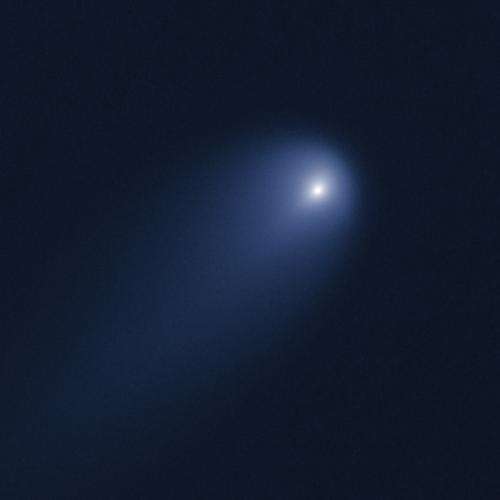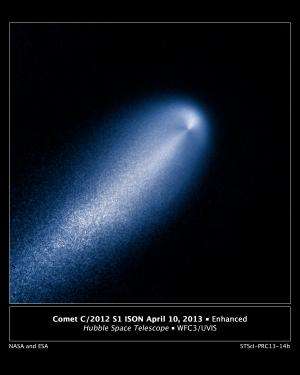Hubble brings faraway comet into view

(Phys.org) —The NASA Hubble Space Telescope has given astronomers their clearest view yet of Comet ISON, a newly-discovered sun grazer comet that may light up the sky later this year, or come so close to the Sun that it disintegrates. A University of Maryland-led research team is closely following ISON, which offers a rare opportunity to witness a comet's evolution as it makes its first-ever journey through the inner solar system.
Like all comets, ISON is a "dirty snowball" – a clump of frozen gases mixed with dust, formed in a distant reach of the solar system, traveling on an orbit influenced by the gravitational pull of the Sun and its planets. ISON's orbit will bring it to a perihelion, or maximum approach to the Sun, of 700,000 miles on November 28, said Maryland assistant research scientist Michael S. Kelley.
This image was made on April 10, when ISON was some 386 million miles from the Sun – slightly closer to the Sun than the planet Jupiter. Comets become more active as they near the inner solar system, where the Sun's heat evaporates their ices into jets of gases and dust. But even at this great distance ISON is already active, with a strong jet blasting dust particles off its nucleus. As these dust particles shimmer in reflected sunlight, a portion of the comet's tail becomes visible in the Hubble image.

Next week while the Hubble still has the comet in view, the Maryland team will use the space telescope to gather information about ISON's gases.
"We want to look for the ratio of the three dominant ices, water, frozen carbon monoxide, and frozen carbon dioxide, or dry ice," said Maryland astronomy Prof. Michael A'Hearn. "That can tell us the temperature at which the comet formed, and with that temperature, we can then say where in the solar system it formed."
The Maryland team will use both the Hubble Space Telescope and the instruments on the Deep Impact space craft to continue to follow ISON as it travels toward its November close up (perihelion) with the sun.
Provided by University of Maryland





















